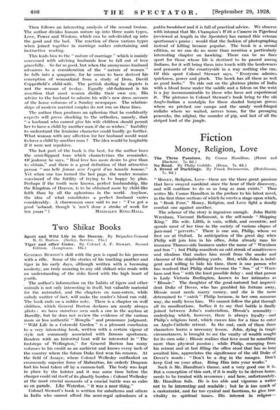Two Shikar Books
Tiger and other Game. By Colonel A. F. Stewart. Second Edition. (Longmans. 16s.) GENERAL BURTON'S skill with the pen is equal to his prowess with a rifle. Some of the stories of his tracking panther and tiger in his early days, although written with a becoming modesty, are truly amazing to any old shikari who reads with an understanding of the risks faced with the high heart of youth.
The author's information on the habits of tigers and other animals is not only interesting in itself, but valuable material for the naturalist, and the chapters on man-eaters, while calmly matter of fact, will make the reader's blood run cold. The book ends on a milder note. There is a chapter on wolf children, which General Burton declares are nearly always idiots : we have ourselves seen such a one in the asylum at Bareilly, but he does not review the evidence of the various more or less authentic " Mowglis " and pronounce judgment. " Wild Life in a Cotswold Garden " is a pleasant conclusion to a very interesting book, written with a certain vigour of style not commonly associated with famous sportsmen. Readers with an historieal bent will be interested in " The footsteps of Wellington," for General Burton has many volumes to his credit as an archivist and knows every inch of the country where the future Duke first won his renown. At the field of Assaye, where Colonel Wellesley outflanked an enormously superior force of Mahrattas, his orderly Dragoon had his head taken off by a cannon-ball. The body was kept in place by the holster and it was some time before the charger could rid itself of its ghastly burden : Colonel Wellesley at the most crucial moments of a crucial battle was as calm as on parade. Like Waterloo, " it was a near thing."
Colonel Stewart's book is written for subalterns and others in India who cannot afford the semi-regal splendours of a
pukka bundobust and it is full of practical advice. We observe with interest that Mr. Champion's With a Camera in Tigerland (reviewed at length in the Spectator) has earned this veteran sportsman's praise : would that the fashion of photographing instead of killing became popular. The book is a second edition, so we can do no more than mention a particularly interesting chapter on hawking. There can be no finer sport for those whose life is destined to be passed among Indians, for it will bring them into touch with the landowners and peasants of the countryside in a way nothing else can. Of this sport Colonel Stewart says, " Everyone admires quickness, power and pluck. The hawk has all these as well as good looks." To ride out on the glorious plains of India with a blood horse under the saddle and a falcon on the wrist is a joy incommunicable to those who have not experienced it. The pictures in Colonel Stewart's book bring to the old Anglo-Indian a nostalgia for those shaded banyan groves where we pitched our camps and the sandy reed-fringed nullahs where we waited, nerves tense, for the presaging peacocks, the nilghai, the sounder of pig, and last of all the striped lord of the jungle.




































 Previous page
Previous page